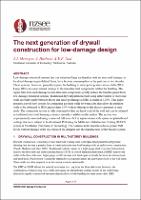| dc.contributor.author | Menegon, Scott | |
| dc.contributor.author | Hashemi, Javad | |
| dc.contributor.author | Gad, Emad | |
| dc.date.accessioned | 2023-08-28T04:23:29Z | |
| dc.date.available | 2023-08-28T04:23:29Z | |
| dc.date.issued | 2023-04-19 | |
| dc.identifier.uri | https://repo.nzsee.org.nz/xmlui/handle/nzsee/2593 | |
| dc.description.abstract | Low-damage structural systems that can withstand large earthquakes with no structural damage, or localised damage in pre-defined fuses, have become commonplace in the past one to two decades. These systems however, generally require the building to undergo large inter-storey drifts (ISD). Large ISDs can cause serious damage to the non-structural components within the building. The repair bills from such damage to non-structural components greatly reduces the benefit gained from low-damage structural systems. Traditional drywall partitions built using either timber or steel stud walls are built rigidly between floors and undergo damage at ISDs as small as 0.25%. This paper presents a novel new system for connecting partition walls between slabs that allow the partition walls to be subjected to ISDs greater than 1.0% with no damage to the plaster (gypsum) or steel studs. The connection system is fully contained within the head track of the wall and can be adopted in traditional steel stud framing systems currently available on the market. The system was experimentally assessed using a series of full-scale 3x3 m square rooms with square set plasterboard ceilings that were subject to bi-directional ISD. The system can be tuned to achieve greater ISD levels without damage at the discretion of the designer. | |
| dc.language.iso | en | |
| dc.publisher | New Zealand Society for Earthquake Engineering | |
| dc.relation.ispartofseries | 2023;134 | |
| dc.subject | Advancements in structural and geotechnical assessment and design | |
| dc.title | The next generation of drywall construction for low-damage design | |
| dc.type | Article | |

